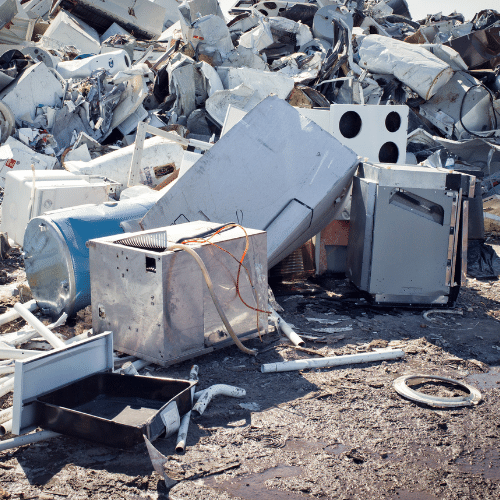What is Green Demolition?
Sustainability is the worldwide cry to halt projects that lead to extreme amounts of waste, and figure out a way to reuse materials to achieve an ecological balance. Several initiatives have been born out of this effort, and green demolition is one of them.
Construction has often been “out with the old and in with the new”, but today we ask the question: what do we do with the old stuff? Construction companies have caught on to the drive toward sustainability and have implemented changes or partnered with companies that deal in recyclable construction materials.
Even the Environmental Protection Agency (EPA) has weighed in, setting standards across the board for the best ways to process demolition materials. Just like many green technologies and processes, the finer details are still being worked out, and the benefits are worth the effort.
What’s the Problem with Construction Waste?
Construction and demolition (C&D) waste has gained the attention of the EPA, and they define it as “materials consist[ing] of the debris generated during the construction, renovation and demolition of buildings, roads, and bridges.” While demolition produces the lion share of waste, many construction projects involve a demolition phase that produces massive amounts of waste as well.
The EPA’s most recent data showed that C&D is a significant problem in the US. It’s alarming when you consider the fact that the amount of C&D waste was 600 million tons in 2018. This is a lot of waste, as the EPA estimates that C&D waste was only 130 million tons in 1996, and 176 million tons in 2003. It’s easy to see where this increase is coming from, as construction waste only generates about 10% of C&D waste, while demolition produces 90% of the waste.
The amount of waste from C&D projects is skyrocketing, that’s not all bad, considering it means construction projects are flourishing. This is good news for salvage yards, scrap metal and companies that deal in second-hand appliances, as there’s a huge need for their services.
However, it also means that sustainable salvage yards who sift through demolition debris for recyclable metals and materials, have to price their services better than landfills. If landfills are cheaper, and regulations for the proper disposal of waste are not in place, then sustainable materials are effectively being thrown away, or incinerated.
This is to be avoided at all costs, as materials such as concrete, steel, wood, asphalt and gypsum can all be recycled, or even repurposed at a C&D site.
What is Green Demolition?
Green demolition is one of the answers to a global trend toward sustainability. Green demolition is applying the “three Rs” -- reduce, reuse and recycle -- to the dismantling of buildings, houses and other structures. Green demolition is also the result of forward thinking, as so many building materials can be reused for future projects.
The good news is that the construction industry in the US, and worldwide for the most part, have embraced green demolition, and have implemented effective laws and guidelines that ensure future projects are embarked upon with sustainability in mind.
The Leadership in Energy and Environmental Design (LEED) certification is an example of the kinds of incentives that are in place for the construction of residential and commercial buildings. LEED lays out the sustainable framework for building and interior design and construction, operations and maintenance, neighborhood developments and homes.
Local governments are starting to take action as well, as there are now six states and seven cities in the US that have laws against the disposal of organic waste, and another 27 states have adopted requirements for at least one recyclable material for every new construction building.
The bad news is that the demolition industry is lagging behind, and as mentioned previously, demolition projects are producing the lion’s share of construction waste. Sustainability is being implemented in the construction industry, and demolition and supporting industries need to catch up.
Considering all the incredible materials and equipment that come out of demolition projects, it’s easy to see how there’s a lot of opportunity in green demolition.
What Can be Salvaged Through Green Demolition?
Did you ever consider selling your old kitchen when you renovated it? Perhaps your kitchen was old and dilapidated, but if not, your cabinets, tile and of course, your appliances could all be reused or repurposed. The same mindset exists when applied in commercial renovation or demolition projects as well, except there’s even more material and equipment that can be reused.
Materials that can be reused range from fine finish work, to roofing and even support beams. Hardwood floors, carpeting, wood beams, fixtures and appliances, aluminum siding, windows and doors are all examples of materials that have several household and commercial applications. You’d be hard pressed to find a building anywhere that doesn’t contain at least one of those materials.
But that’s not all, as materials like ferrous and non-ferrous metals, which are all over buildings, transportation infrastructure and homes are being effectively implemented. The marriage of incentives and sustainability is important to drive green demolition, and when it comes to metals, the world has it figured out.
For example copper retains 85-95% of its value when compared to raw ore, making the mining of new copper almost completely unnecessary. Ferrous metals are priced at an all time high, making it worthwhile for demolition and salvage crews to sift through debris to find the metals. Aluminum is another example, as 75% of aluminum that’s in use today is recycled.
So there’s a lot of opportunity out there for recycling materials and equipment now that the incentive for putting the “three R’s” into use is starting to catch up.
If recycling materials becomes more economical than sending them to a landfill, then green demolition will continue to grow on a global scale. C&D won’t be going anywhere anytime soon, so as long as green demolition teams up with this reality, the whole world wins.


